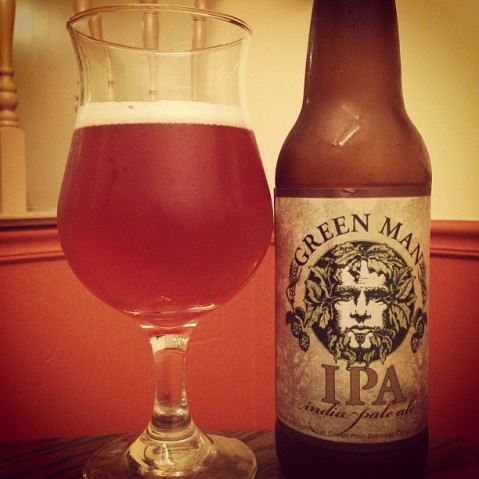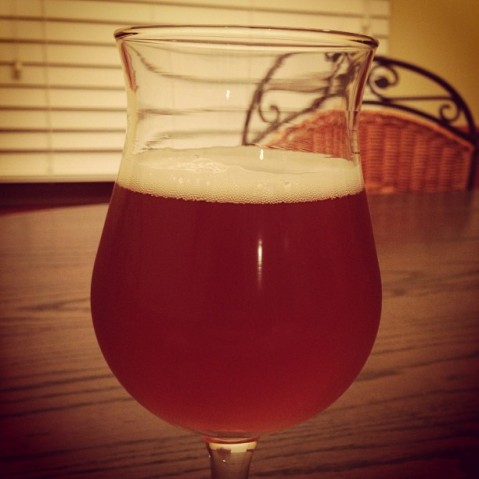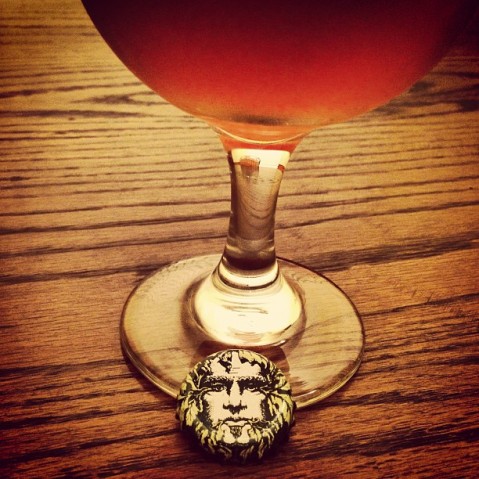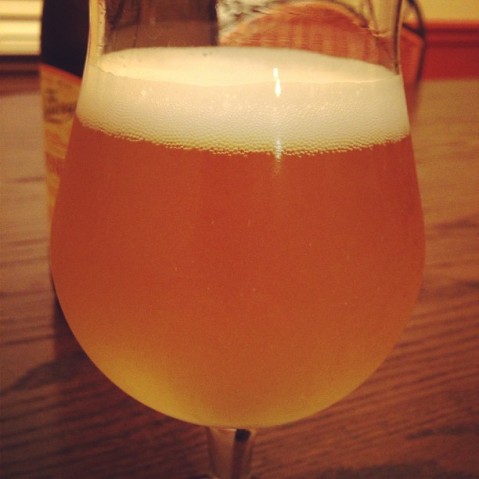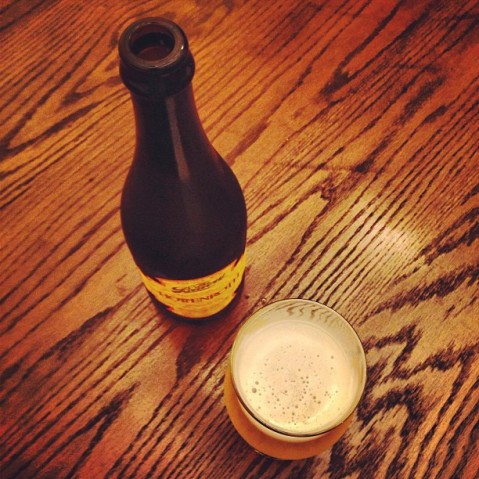Beer Review 0589: Boulevard Chocolate Ale
Boulevard Brewing Company started as a traditional Bavarian brewhouse on Southwest Boulevard in Kansas City. The first beer made, in 1989, was Boulevard Pale Ale, and John McDonald, the founder, delivered the first keg of it to a local restaurant. Fast forward to 2006, when the brewery made major expansions, increasing from a modest 6,000 barrels to the aforementioned 600,000 barrels. Quite a jump!
Recently, Boulevard was purchased by Duvel Moortgat, a family-controlled Belgian brewery who also own Brewery Ommegang, another Belgian-inspired American beer maker.
In addition to a full regular line-up of beers, Boulevard makes a “Smokestack Series,” which are all big beers in big bottles. Consider it the experimental side of Boulevard — Chocolate Ale is a collaboration with chocolatier Christopher Elbow, who also conducts business in Kansas City. Elbow earned his reputation by teaming unusual and surprising flavors with chocolate; with Boulevard, Elbow recommended that the beer be dosed with a rare variety of cocoa nibs from the Dominican Republic. For the 2014 version, over 3,000 pounds of Valrhona nibs were added; the outcome was a 9.1% ABV (alcohol by volume) beer that hits just 24 IBUs (International Bitterness Units).
Chocolate Ale is typically released just before Valentines Day — Boulevard skipped the beer in 2013 due to quality control issues, but it returned this year. It typically disappears off shelves quickly.
The pour produced a large, frothy head composed of large bubbles. It lasted atop a orangeish-amber colored beer. If you were expecting a Brown Ale or Stout, guess again; this is much lighter than anticipated. The body is a touch hazy, but there are no particles or sediment. Lacing never really existed, and you can’t regenerate the head; once this is poured, it’s pretty much flat.
Expectations denied, once again: if you’re expecting a rush of chocolate on the nose, no can do. Be prepared for a ton of Belgian yeast; slight notes of bread, dough, with plenty of orange peel and a bit of banana. There is some milk chocolate here, but it’s very powdery and dry, and most certainly buried beneath everything else going on. As it warms, the chocolate comes out more, but it’s quite mild, and teams with some citrus and herbal hops. There’s no alcohol present despite the big ABV number, but overall, this aroma doesn’t match the hype on this bottle.
On the palate, the initial notes are of banana, Belgian yeast, and orange peel. The chocolate finally joins in after a few warm-up notes, but it’s milk chocolate, and there isn’t much depth to it. You know those oranges that are actually chocolate and when you smack them on the table turn into about 50 piece of chocolate? This beer tastes like that — and a bit of Tootsie Roll. There’s some pleasant vanilla, which actually overshadows the chocolate, and the finish has some salted caramel notes. But the chocolate is a timid flavor that you have to hunt for, and I’m not very enthused by that considering the name of this beer is ‘Chocolate Ale.’ The beer has a little alcohol heat at the very end; it’s medium-bodied with a thin, foamy mouthfeel.
I was very excited about Chocolate Ale, especially after Boulevard started distributing to North Carolina just last year and decided not to release it due to quality issues. To say this beer didn’t live up to the hype is totally correct. To say it’s a bad beer would also be false. This is a pretty tasty drink, interesting for sure, but it’s no Chocolate Ale. It’s like a cross between a Dubbel and Quadrupel. Oh, well.
Boulevard Chocolate Ale, 81 points. Price: $12.99 US for one 750 ml. corked & caged bottle.
Beer Review 0584: Victory Swing Session Saison
I can’t speak for everyone, but it feels like it has been a very long winter. I’m ready for spring — the beer we’re looking at today, Swing Session Saison, is a beer that is supposed to thaw out these last few days of winter and remind you that spring is just around the corner.
The story of Victory Brewing Company (Downington, Pennsylvania) goes all the way back to 1973 — granted, the two principal founders were only in fifth grade, meeting for the first time on a school bus that would take them to a new school. Friends like that are hard to find; the two remained bonded as they went to college, on opposite sides of the coast.
Their names are Ron Barchet and Bill Covaleski, and when Bill finished college, he explored making beer using his father’s home brewing equipment. It just so happened that Ron was into beer, too, and gave Bill a home brewing kit for Christmas in 1985. A friendly rivalry ensued, but the passion for beer caused both men to quit their jobs in the corporate world and seek out brewing.
Bill did his brewing studies at Doemens Institute in Munich, Germany, while Ron also honed his beer making skills in Germany. But before Victory churned out its first drop of beer, Ron returned from Germany and became the brewmaster of Old Dominion Brewing Company, increasing yearly production there from 1,500 barrels to 15,000.
On February 15, 1996, Victory Brewing Company opened up in a former Pepperidge Farm factory. In the first year, they made 1,725 barrels; in 2011, expansion had increased that number to 82,000.
Swing Session Saison is just what the name implies — a “session” beer that is low in alcohol and meant for a session of drinking. Coming in at just 4.5% ABV (alcohol by volume), this beer is brewed with rye, oats, and wheat, and uses both German and American hops. There’s also some spices involved: peppercorns, orange peel, and lemon zest. Ferment all of that with a Belgian Saison yeast, and this is how Victory chooses to usher in springtime.
Pouring from the bottle issued up an average size, bright white head that was soapy in texture and quickly reduced into just a thin foam over top of the beer. Color was vivid yellow, certainly helped by the clarity — this brew is exceptionally clear, featuring no particles or sediment, only carbonation bubbles that force their way to the top in a hurry. Lacing is good, leaving behind patchy yet bubbly film.
The nose is exactly what you’d expect from a session Saison — the yeast flavors are somewhat muted, but they’re here, with notes of earthy dough and bread. I was surprised by the amount of spicy peppercorn, and there’s plenty of citrus, mainly orange peel. The backing is of straw and grain, with hints of clove, bubblegum, and flowers.
The taste starts sharp with very lively carbonation, bringing on flavors of peppercorn and orange peel. There’s a solid grain backbone that serves as the canvas; the yeast almost has a Brettanomyces-like feel and flavor going on. The finish dials up the citrus, equal parts orange and lemon peel, while there is some moderate bitterness that dries out the palate and readies it for another sip. Swing Session is light-bodied, with a thin, foamy mouthfeel.
It’s nice to see a session beer that isn’t an IPA, but this one left me wanting a full-bodied Saison. I think they’re refreshing as is…maybe not sessionable. The flavors here (while good) are just a tease. I’d like to taste this beer at full-bore — perhaps Victory could make that possible — still, it’s refreshing and easy to drink, just not the road I would have went down when making a lighter Saison.
Victory Swing Session Saison, 81 points. Price: $1.99 US for one 12 oz. bottle.
Beer Review 0497: Hacker-Pschorr Original Oktoberfest
Hacker-Pschorr, located in Munich, traces its roots back to 1417, nearly 100 years before the Reinheitsebot Beer Purity Law, an order which dictated the only ingredients that could be used to make beer were water, barley, and hops. (Yeast had yet to discovered.) Yeah, that’s a really long time to be making beer.
Fast forward a little to the 18th century, when Joseph Pschorr bought the Hacker brewery from his father-in-law. Pschorr also founded a brewery under his name, so there were two different breweries that he owned — Hacker and Pschorr. Mr. Pschorr had two sons, and each inherited a brewery. They remained separate businesses until 1972, when combined to make Hacker-Pschorr.
For over 580 years, the brewing process has remained unchanged. Their most popular offering, Hacker-Pschorr Weisse, has always retained the same recipe using spring water, Hallertau hops, and a proprietary yeast strain.
Hacker-Pschorr Oktoberfest dates back to the origins of the celebration — Ludwig I, the Crown Price of Bavaria, decided all of Bavaria should celebrate his wedding. So, in 1810, he commissioned Munich brewers to develop special beers to commemorate the ceremony. Known as Oktoberfest today, it’s celebrated worldwide, yet only the original six Munich breweries that first produced the celebratory beer are invited to serve their beer during the celebration in Munich. Hacker-Pschorr is one of those breweries; their Oktoberfest, which is brewed year-round because of popularity, is produced with barley from the Bavarian countryside. The brew comes in at 5.8% ABV (alcohol by volume).
Pouring made for an average size, soapy head that quickly diminished. Color of the beer was in between dark golden and light amber; the body was crystal clear and featured no particles or sediment. Lacing was fair, leaving a decent amount of soapy film on the side of the glass.
The nose is spot on for an Oktoberfest, with lots of caramel, sweet bread, biscuit malt along with plenty of grain and wheat. There’s a small but detectable hop presence that is herbal and spicy, and it even has a bit of faded orange peel in there. It’s all supported by an earthen yeast. Very pleasant and inviting.
The taste is a bit bland to start, with watered-down caramel and a bit of a papery, cracker-like flavor. It’s a strange start and off-putting but the beer does open up significantly to warm notes of sweet caramel, orange peel, and wheat. There’s not much complexity here and the body is light, with a thin, foamy mouthfeel. On the finish, we’ve got sweet bread and just a slight edge of spicy, herbal, lightly bitter hops, and residual burnt orange peel. It’s clean and sets the stage for the next sip.
Honestly, for a beer with such a storied history, I was disappointed. After a shaky start, the beer did improve; however, that paper/cardboard flavor is enough for me to not really want to return. It’s easy drinking, non-offensive, but I’ve certainly had better from the style.
Hacker-Pschorr Original Oktoberfest, 81 points. Price: $1.99 US for one 11.2 oz. bottle.
Beer Review 0431: Green Man IPA
Green Man Brewery is located in Asheville, North Carolina. Founded in 1997 as a brewpub, things changed in 2010 when new ownership took over. The brewpub was closed and Green Man began to focus on production brewing, with the original brewer John Stuart at the helm. This shift in focus allowed Green Man to begin distributing bottled beer at the beginning of the year (previously, all you could find were growlers in my area).
What exactly is a green man? It’s a sculpture, drawing, or other representation of a face made from leaves. It’s used as a decorative element in many cultures; the brewery decided to put its green man on every bottle crown, and it’s a very nice looking package.
Green Man’s IPA is their flagship offering, and is brewed in the style of a traditional English IPA, which is meant to be balanced. Coming in at 6.2% ABV (alcohol by volume), the beer is hopped late in the kettle to create a floral hop aroma. The IBUs (International Bitterness Units) call in at 63.
The pour produced a small, soapy head that had staying power. The beer was copper colored when held out of light, in light, it became more amber with golden highlights. The body was clear, with no particles or sediment, and lacing was fair, leaving behind a couple of thick, soapy sheets.
The aromatics do present a balanced picture with grapefruit and lemon hops leading the way, followed by a nice backing of bready caramel and toasted notes. Dig deeper and you find the hops are fairly floral, have a touch of pine to them, and as it warms, get a touch catty. I’d say the ratio of hops to malts here is pretty much dead even. You might would have a hard time identifying this as an IPA just by smell alone.
On the taste, we’ve got extreme floral and grapefruit hops up front, but those fade and lead into more of a toasty bread/caramel middle. Playing out in other layers of the palate are some orange peel and lemon; but when the finish comes on, this IPA definitely gets out of balance — the final flavors are moderately to heavily bitter, and it has a strange medicinal/salty note on the very tail end that lingers and overpowers all the malty nuances. Green Man IPA is medium-bodied, with a thin, foamy, drying mouthfeel.
Everything was going well until the finish, and I thought the beer really came apart with the bitterness. To my palate, some IPAs can get so bitter that they have a salt-like taste; and while this is only 63 IBUs, perhaps the interplay of the hops and malts makes it seem much more bitter than it is. After one of these, I’m ready to move on.
Green Man IPA, 81 points. Price: $1.49 US for one twelve ounce bottle.
Beer Review 0389: The Bruery Hottenroth Berliner Weisse
The Bruery opened in 2008, the home brew product of Patrick, Chris, and Rachel Rue. Patrick and Chris are brothers; Rachel is the wife of Chris. The first home brew batch the three made was an amber ale with Cascade hops; as the years went by, Patrick, who was going to law school, saw his beer passion become bigger than his law studies. He decided the rest of his life should be dedicated to making beer, so he got loans and started The Bruery, which is a fusion of his last name, and well… Brewery.
Located in Placentia, California, most of The Bruery’s beers are considered to be experimentations brewed in the Belgian tradition. None of their beers are filtered or pasteurized; all are bottle conditioned and use a proprietary Belgian yeast strain.
Hottenroth, a Berliner Weisse, has to be a special beer for The Bruery, as it is made in memory of Patrick’s grandparents, Fred and Sarah Hottenroth. The beer fits the Berliner Weisse style to a tee, coming in at just 3.1% ABV (alcohol by volume) and using lactobacillus and brettanomyces yeasts to sour the base wheat ale. Traditionally, Berliner Weisse beers are served with raspberry or woodruff syrup as a way to sweeten the beer. The bottle even mentions this serving suggestion, but we’ll just sample the beer sans any kind of syrup for this review.
The pour issued up a large collar of bright white foam, frothy in texture, fast diminishing. The beer was pale straw yellow in color, even paler than industrial macro-lager. The body was cloudy but contained no particles or sediment; it should be noted that the back of the bottle asks you to not disturb sediment at the bottom of the container. Lacing never existed.
On the nose, there’s some initial Granny Smith apple, tart and unripened, coupled with apple cider vinegar. There’s a solid wheat backing, which plays off well with the doughy, earthen yeast that is just a touch funky. I also pulled out a little pear and lemongrass.
The taste has a lot of tart apple up front, a gentle sourness, and then it all shuts off, only leaving a wheat flavor — it’s like the beer goes dead until the swallow, when the finish comes on moderately sour. The beer finally gives up all its flavors; unripened apple, pears, and a dash of lemon meet straw, and the finish leaves quickly. After a few seconds following the sip, the only thing left is some cereal grain. Light-bodied, Hottenroth has a light mouthfeel, foamy when swirled, and an average carbonation.
This beer is quite refreshing as Berliner Weisse tend to be, but it’s really light on flavor. Yeah, that’s the point, to a certain extent…but toward the end of my glass, this became like drinking tart water with a little apple flavoring. You can tell this is a well-made offering, but the value doesn’t match what’s here, in my opinion. It does work great on a hot, sunny day.
The Bruery Hottenroth Berliner Weisse, 81 points. Price: $8.99 US for one 750 ml bottle.












